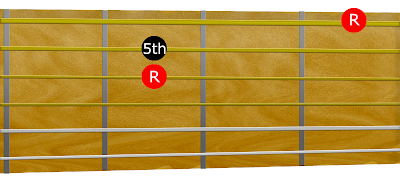In part b of this lesson on fifth intervals, I'm going to tell you about power chords. You may already be familiar with this as it’s an extremely popular technique in western pop and rock songs.
A power chord is simply the one note, a fifth interval note, and (optionally) an octave note played together.
There is no major third interval note to make the chord either major or minor.
Playing power chords is really common, in western pop and rock music. Let’s look a well known example: Eye of the Tiger, by Survivor:
Play the intro to Eye of the Tiger
We’re going to start by picking out the bass notes.
Starting on the fifth string, find the C note and the B note. And I want you to play:
C, C, A#, C.
C, A#, C
I want you to do that by yourself, using the knowledge you already have from these lessons (a demo video will be posted here in October 2023 so please check back then for an update if you need to).
Find those notes on the fifth string of your guitar:
C, C, A#, C
C, A#, C
When you have that worked out, you need to add two final notes on the low E string - the notes G, and G#.
Find the G and G# notes on your sixth string, and play:
C, C, A#, C
C, A#, C
C, G, G#
So now we have the bassline figured out, we can go ahead and make these single notes into power chords, by adding the fifth interval.
Here's a reminder of what the fifth interval shapes for power chords look like on the fretboard. Remember, the fourth interval note is always directly below the root note, so we simply move up two frets from the perfect fourth, to the flat fifth, and then to the perfect fifth:
And that shape is fixed as you move down all the pairs of strings, until you hit that B string, and then you need to move the fifth interval down the fretboard by half a step - just as we’ve been doing throughout this whole course:
I want you to play that bass line again, but this time, add in the fifth interval note.
Learning these kinds of riffs, with fifth intervals, will really help you to memorise how to find your fifth interval notes, whenever you might need them.
To finish this session, I just want to explain that underneath your fifth, when you play a power chord, you have your eighth note - or your octave note. It’s the same as your root note, just one octave higher.
It’s useful to just make a mental note of this,because that’s a good way for you to build confidence in moving up and down the fretboard, as you develop as a player.
If you know where your next root note is, you can start to move into a whole new position, and find your thirds, and fifths from that root note too!
But understanding that we have an octave note underneath our fifth means we can invert our power Chords. We can play the fifth interval note on top, and the root note right beneath it.
This is what we find in songs like Smoke on the Water.
Guitar practice journal
Download the Guitar Practice Tracker today. It will help to keep you motivated and give you a visual representation of your progress, and areas of focus throughout the year.
A guitar journal will enable you to:- Set personalised goals and monitor your progress
- Identify the number of hours or days you've spent on a particular skill
- Provide a quick reference to the notes and chords in a particuar key
- List the songs you know and sort by key, capo placement, artist, and chord progression
- Link directly to your favourite YouTube videos and tutorials
Download the Guitar Practice Tracker
Go to Lesson 7: How to spell major chords
If you enjoyed this free lesson, and you're able to, please
Photo by Brett Sayles






